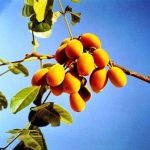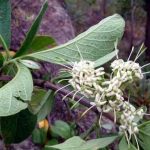TREE LIFE
August 1998
MASHONALAND CALENDAR
Saturday 1st August. Botanic Garden Walk. Our field cards list some tantalizing names of trees unseen (or forgotten) by most of us. On this walk Tom will show us some of these unusual and sometimes rare specimens. As we walk in the gardens we will also revise the Grewia genus. It would be useful to bring along the Grewia key which was distributed with Tree Life many years ago, but if yours is mislaid there will be some spare copies. We will meet Tom in the car park at 10.45 for 11 a.m. – there will be a guard for the cars.
Sunday 16th August. Phil and Tutty Mugford have been on their property in the Shamva area along the Mazowe River for only 4 years. During this time with hard work and ample water the garden has developed at a staggering rate with a good variety of indigenous trees all lovingly preserved. We will spend the morning close to the house where there is much of interest, and in the afternoon we will look along the river. Meet at the homestead at 9.30 a.m.
Saturday 22nd August. Mark’s Walk this month will be on Dido de Swardt’s beautiful property – Midsummer Hill Nursery in Glen Lorne.
Tuesday 1st September. Please note our Botanic Garden Walk is rescheduled to Tuesday evenings for the summer season.
MATABELELAND CALENDAR
Sunday 2nd August. August 8th-12th Visit to Nyoni Hills and Buchwa. You can still be on this trip. If you are interested please make contact with Anthon in Bulawayo.
DENDROLOGY ON DEVONIA
Sunday 21 June saw a good turnout at the base of a kopjie on the farm Devonia belonging to Liz and Dennis Lapham. Judging by the member response, the opportunity to buy cheaply priced naartjies (sorry unable to recollect the Queen’s English term) was in itself sufficient justification for the outing. The excursion commenced with Andy being tasked with the unenviable duty of trying to bring botany to the masses (in also everything but the Queen’s English especially when it came to the common name of one of the Strychnos trees, so I felt in good company).
It wasn’t long before we split into two groups, all on the identification of a fig tree. We had the silent majority, the Ficus glumosa group headed by Sue and Andy and the Ficus sycomorus group of one or two members. At the grave risk of falling out with Sue’s dad, the noted naturalist Rolf Chenaux-Repond and Andy, my trusty computer aide and fundi, I would like to categorically state that what we ultimately and reluctantly conceded may look a bit like Ficus glumosa is definitely a sycamore fig! The opinion of he/she who writes the newsletter rules, OK! First thing on Monday morning I went to have a closer inspection of a Ficus glumosa that grows in my surgery garden. What I saw was a large-leafed fig with extremely long hairs on the upper surface of the leaf. The broad dry bracts associated with the buds were huge, at least 4cm in length and as for the leaf, the outer exposed surface was covered in long white hairs. The hairy impression I got from leaf and bract was that one could easily comb a pattern in all this pubescence.
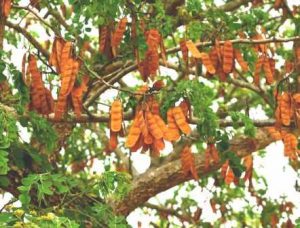
Albizia versicolor. Photo: Bart Wursten. Source: Flora of Zimbabwe
A vocationally derived interest in livestock poisoning by plants allows me to blend an interesting profession with an enjoyable hobby, making field trips with whichever group absorbing. This made Albizia versicolor my best find of the day. The pods, as stated in an earlier newsletter are toxic to cattle. However, one specimen we were looking at had less than a dozen bright red seedpods edged in green. Back in October and November, this tree must have been a show of young velvety leaves and possibly a thousand flowers. Isn’t it amazing, the lack of return on investment? I’ve witnessed this same “poor performance balance sheet” in mopane and Albizia antunesiana in certain years, irrespective of the rainfall. These poor yield years may then be followed by a seemingly similar year where the trees are just weighed down with fruit. How fortunate fauna and flora are not to be saddled with such trivia as the sordid business of producing pleasing balance sheets. Another poison pod Albizia must have once been a magnificent specimen but had been cut down at a height of about three meters. Had whoever cut the tree down done this to prevent livestock poisoning, for if it had been cut for timber it would have been felled at ground level resulting in low down coppicing and subsequent pod production well within the reach of future livestock.
Another plant that was plentiful but not very eye-catching was Lippia javanica. This is a strong-smelling shrub that causes liver damage and secondary photosensitivity, a lot like Lantana camara.
Interestingly, two of the greenest, quite eye-catching and seemingly well-adapted trees to this hot granite hillside were a mango that from a distance held promise as a Rauvolfia and a Mexican apple tree probably seeded by a fruit bat.
To me the Combretum erythrophyllum growing on the top of the hill was quite a surprise find. If I had been expected to place this tree in an indigenous garden I would definitely have placed it along a water course! Is it Meg who insists that botany can’t be pigeon-holed? The day prior to this outing had seen me taking an early morning jog along the newly developed Borrowdale Brooke Golf Course which is planted out in indigenous trees with different holes representing different parts of Zimbabwe. (Worth a visit in the future). All these young trees with labels gave me ample opportunity to be distracted from the intended exercise. Vernon Dickinson, the course landscaper had placed a group of Combretum erythrophyllum well away from water. Aha, thought I, wait till I see Vernon. What a great leveller this kopjie on Devonia turned out to be the next day (but sorry Sue, I’m still not going to concede on that fig).
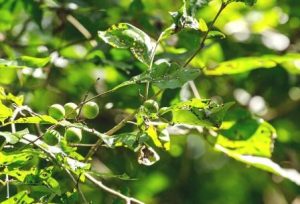
Strychnos potatorum. Photo: Bart Wursten. Source: Flora of Zimbabwe
The kopjie proved to be basically quite average as far as species diversity is concerned. Strychnos potatorum grew alongside a Strychnos spinosa. Ficus ingens was accepted by all. Senna singueana was about the only splash of colour at this time of year. I never saw an aloe which may have disappointed some of the expectant Aloe Society members. The south face of the hill was fairly different as it had no undergrowth below the mainly Uapaca trees that were nearly absent from the north face. Golden orb spiders with webs spanning many of the gaps between the trees added an extra facet to walking at this time of year often forcing one to deviate from one’s intended route.
Lunch was enjoyed in the park-like surrounds of the Laphams’ garden. In the space of six years a garden covered in (here I will show a great degree of ignorance) numerous Cycads etc. etc. nestling in amongst the natural indigenous flora and various man-made pools gave an atmosphere of comfort and relaxation. Just what was required by the Mtepatepa mob of Browning, Cottrill and Co. enjoying their gin and tonics. An assortment of weld-art birds standing sentry to the Koi effectively called marauding herons and Hamerkop’s bluff. I wish I had known all about these decoys (pro-koi’s?) while the fish in my ponds existed.
Thanks to Liz and Dennis for their hospitality. I wish the new tar road to my house were as well maintained as the thirty-odd year old strip road on your farm!
-Karl van Laeren.
Wandering around Northern Malawi (Cont.) The Montane Forests
There are several areas of substantial montane forests occurring in the Northern Region of Malawi, namely, on the Misuku Hills which lie about seven to ten kilometres south of the Songwe River, which is the border with Tanzania, the Mafinga Mountains on the Chitipa Zambian border, on the Nyika Plateau and on the Viphya Hills lying to the north and south of the regional capital Mzuzu. Many of the forests are of considerable sizes and some of them are to be found on the top of ranges of hills and along quite steep ridges.
I did not visit the Mafinga Mountains; however, I saw them while travelling up the road from the western side of the Nyika to Chitipa. I visited parts of the Misuku Hills, the Nyika Plateau, Uzumara Forest and forests around Mzuzu on the Viphya Hills. Generally, these montane forests are fairly similar to those of Zimbabwe though the average size of the emergent trees appears taller and there are quite a few common, and even, dominant species that either do not occur or are very rare in Zimbabwe. I will describe and give my impressions of the forests below.
Firstly the forests of the Misuku Hills just south of the Tanzanian border. There are three forest reserves, Matira in the West, Wilindi in the centre and Mugesse in the northeast. I visited Wilindi, which must be about 14km2. This forest is approached from a road that goes north from the main Karonga Chitipa Road just over twenty kilometres east of Chitipa. It was the most impressive forest that I saw in Malawi, which is quite surprising as it lies in the middle of Mwenemisuku area, one of the highest populated areas in northern Malawi. The forest is about twenty kilometres north of the main road on the main ridge of the MISUKU Hills. The road should be fair in the dry season, though steep, with four-wheel drive preferable in the wet season.
Most of the forest is in its primary state and there is a road running through the middle of the forest going west along the ridge. The two dominant and emergent trees were Aningeria adolfi-friedericii (Sapotaceae) locally known as mufu and Entandrophragma excelsum locally known as mukarikari. The latter like other members of its genus (Entandrophragma caudatum in Zimbabwe) has its fruits contained in a wooden capsule (wooden banana). The capsules were scattered all over the forest floor, but apparently it was too late in the season (March) to gather seed. I did however manage to collect some seed (I think) of A. adolfi-friedericii and have managed to germinate two seedlings.
Many more commonly known trees from Zimbabwe’s Eastern Districts were there including Chrysophyllum gorungosanum, Trichilia dregeana, Diospyros abyssinica, Albizia spp., Rauvolfia caffra etc. There are three other species that reach their southern limit on the Misuku hills which I did not positively identify but were pointed out to me – they are; Cyclicomorpha parviflora (Caricaceae) the papaya family but it did not really look like a papaya having thorns on its tall trunk and was quite a big tree: Mitragyna robrostipulata (Rubiaceae) I am afraid I did not see this one: Podocarpus ensiculus [now Podocarpus henkelii – ed.] very similar to Podocarpus latifolius but with slightly longer leaves. Also seen more towards the forest fringes Parinari excelsa, very like Parinari curatellifolia or muchakata but much larger and more ‘evergreen’ in appearance: Macaranga kilimandscharica, which looked very like Macaranga capensis to me.
Very characteristic of this forest, and indeed other forests in Northern Malawi were the very large epiphytic Drynaria volkensii ferns to be seen growing high up in the branches of the trees with their very distinct small ‘nest’ fronds and their much larger fertile fronds. Begonia sutherlandii was very commonly growing as an epiphytic on the lower trunks of large trees by pathways and along the forest edges, as was an Impatiens sp., which appeared similar in ways to the often cultivated ‘Congo Cockatoo’.
My only regret is that I only managed to visit the Misuku Hills on two very short occasions. I will always remember them as perhaps the finest montane evergreen forests I have seen. Anyone who visits Northern Malawi should make an effort to visit them even if they are a little off the beaten track!
-Tackie Bannerman
BOTANIC GARDEN WALK: 4 JULY 1998
In warm sunny weather, Tom continued his long-running and fascinating series on lowveld trees.
We examined a fine specimen of Sapium integerrimum (now Sapium armatum) which was in full fruit. Meg mentioned that this is the tree, the photograph of which was used in Coates Palgrave (Illus. 142). The leaves are glossy, serrate and alternate and produce milk (although this specimen was very reluctant to do so). The fruits were weakly 3-lobed and each lobe showed faint evidence of being divided into 2; in addition there were short “horns” at the apex of the fruit, which serve to distinguish this species from the other Sapium in Zimbabwe, namely Sapium ellipticum. Sapium armatum and Sapium ellipticum are con¬fined to the Eastern Districts but Sapium ellipticum is much the commoner of the two and we have seen it on several outings to the Eastern Districts.
Although our species is now Sapium armatum, Sapium integerrimum still remains as a species, but it is confined to coastal habitats in Mozambique and South Africa.
Nearby was Phyllanthus engleri, the Spurred Phyllanthus. This is a rare species of Zimbabwe’s northern parts (recorded also from Zambia, Mozambique, Malawi and Tanzania and therefore presumably at its southern limit with us). Tom said he had only seen it at Chipoli D and the Tree Society has also seen it at Hippo Pools near to the Umfurudzi River.
Just as opposite leaves are uncommon in the Euphorbiaceae, so too are compound leaves, but like other species of Phyllanthus, this one pretends to have compound leaves; however these are really branches as may be seen from the fact that fruit and flowers occur amongst the “leaflets”. However, the situation is genuinely confusing because the leafy branches are deciduous and fall off each year in the same way that a compound leaf would.
On to Combretum apiculatum, seen “everywhere in the lowveld”. It is excellent firewood, so it is usually more or less degraded by man. Tom demonstrated on the example that it has a pale lemon-yellow slash, the only Combretum which does – all the others are red or orange.
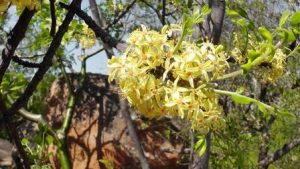
Ptaeroxylon obliquum. Photo: Brian Orford. Source: Flora of Zimbabwe
We next looked at Ptaeroxylon obliquum, the Sneeze-wood, which is in a family of its own, the Ptaeroxylaceae. The common name refers to the irritant nature of the very fine sawdust. Although well-known in the Matopos, it is not confined to there but occurs elsewhere in southern and western Zimbabwe. The leaves are compound and paripinnate, which as we have noted before is an unusual characteristic outside the Caesalpinioideae. Two spot-characters for this species are the often winged rachis and secondly translucent spots and streaks in the lamina, which are visible when the leaf is held up to the light. The base of each leaflet is highly asymmetric, or oblique, which one would guess is the origin of the specific name.
In passing, we looked at Coffea racemosa, a lowveld species of coffee. It has very glossy leaves with crinkly margins and occurs in Zimbabwe only in the south-eastern lowveld. Its family is the Rubiaceae, so the leaves are opposite and there are deciduous interpetiolar stipules. Tom reported that like many lowveld trees its flowering (it produces numerous pink flowers) is a one day wonder.
Tom then showed us the riverine form of Ziziphus mucronata, which has very glossy leaves and is not very spiny. Tom feels that although it is not at present recognised taxonomically, it should be. It differs from the glabrous subspecies of Ziziphus mucronata. A similar unrecognised taxon is the extraordinary form of Strychnos spinosa which occurs in the lowveld.
An interesting Grewia, just coming into flower, was Grewia sulcata. It is often a multi-stemmed shrub or a small tree and it occurs in the lowveld in the southeast. The flowers are white, which is slightly less common than yellow flowers in this genus, and the leaves are glossy. The fruits occur singly or in pairs.
Another interesting (and rare) Grewia is Grewia hexamita. This occurs only in the extreme south of Zimbabwe, just N of the Limpopo. The leaves are roundish, asymmetrical and glossy above. An unusual feature is the large fruits in pairs.
It was decided that next month we would revise the Grewia.
Once again, our thanks go to Tom for a very interesting session.
-Mark Hyde
MORE NOTES FROM THE LAY-BYS
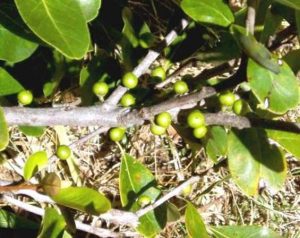
Sideroxylon inerme. Photo: Mark Hyde. Source: Flora of Zimbabwe
Sideroxylon inerme (white milkwood) is a tree or shrub with an interesting distribution. It occurs along the southern African coast from the Cape into Mozambique, extending inland to Swaziland and up the South Africa/Mozambique border into the southeast of Zimbabwe. This means that the species is found in three different climatic zones – winter rainfall, uniformly distributed rainfall, and summer rainfall – but it could be argued that its incursion into the harsh conditions of the northern Transvaal and Zimbabwe lowveld actually takes it into a fourth climatic zone. There are supposed to be three subspecies, but the textbooks are not in agreement about which of them occurs in Zimbabwe. The species is quite common around Kenton-on-Sea, but I found it very difficult to key it out from van Wyk & van Wyk’s Field Guide to Trees of Southern Africa because of the general absence of milky latex. This was probably due to the long and severe drought experienced in the region from the middle of last year to well into February this year. You had to squeeze the leaf petiole really hard to see any suggestion of milk. The fruits of Sideroxylon inerme are said to be edible, but one authority, T R Sim, observed in 1906 that “This statement requires qualification; the fruits are sweetly milky, but the milk coagulates into a sticky rubber”. And that was enough to put me off trying to eat any!
The wood of Sideroxylon inerme has the reputation of being very hard, which is reflected in its generic name derived from the Greek sideros (iron), and xylon (wood). Around the end of the last century the wood was regarded as one of the best Cape timbers for local boat making.
There are three historic specimens of Sideroxylon inerme in South Africa, one of which we have seen at Mossel Bay. This is the well-known “Post Office Tree”, which is reckoned to be at least 600 years old; it has been self-layering for very many years, and now occupies a considerable area of land. It is said that in the year 1500 Portuguese sailors tied a shoe to the tree as a receptacle for a letter addressed to Commander Joao da Nova giving details of the death by drowning of the explorer Bartholomew Diaz. More than a year later da Nova himself discovered the letter in the shoe. This tree, and the other two, are National Monuments in South Africa.
Schotia afra var. afra (Karroo Boer-bean) is also quite common around Kenton-on-Sea, and its bright red flowers make it conspicuous and easy to identify. There was not much flowering when we were at Kenton, but enough to make the small trees stand out in the bush along the Bushman and Kariega rivers. The seeds are edible, either partly green or, if mature, roasted in a fire and ground into a meal, and there is evidence that the seeds have been eaten by humans since the Late Stone Age.
Two species of Schotia occur in Zimbabwe, Schotia brachypetala from north to south in the eastern half of the country, and, in the southeast lowveld, Schotia capitata. Both of these are present as planted specimens in the National Botanic Garden in Harare.
Kenton-on-Sea is located between two rivers, the Bushman’s and the Kariega, and the steep-sided banks of both are covered in Euphorbia triangularis (river Euphorbia), which reaches heights of up to 10 metres. The Xhosa people believe that if twins are born into the family the father must go out into the bush and bring back two of these trees to plant side by side in front of the dwelling hut. This age-old custom has great significance: it is believed that the trees will protect the two children from witchcraft, and that the trees and the twins will influence each other throughout their lives. So, if the one dies, the other will also.
A common associate of Euphorbia triangularis along the riverbanks at Kenton-on-Sea is Aloe ferox (bitter aloe), which can grow to a height of about 5 metres, but always single-stemmed. The specific name ferox means ferocious, and refers to the spiny leaves, but most plants have only a few spines, and some have none at all. In times past local farmers have used the leaves for stock fodder during droughts, and they themselves were not above using the leaves to make konfyt. The dried leaves have been burnt as an insect repellent. The early Bushmen appear to have felt something for Aloe ferox, because the species has been depicted in the rock art of at least two caves in South Africa.
The land between the Bushman’s and Kariega rivers that is now occupied by Kenton-on-Sea was bought from the Cape Government in 1878 by a British settler, Charles Butt, who established a tobacco and vegetable farm there. On 6 March 1896 the Norwegian barque VOLO ran aground at the mouth of the Bushman’s River, and Butt played a large part in the rescue of all aboard, including the ship’s cat. For his services, Butt was given half the timber from the wreck, and he used this to build his home on the highest point of his land. He also planted two Norfolk Island pines (Araucaria heterophylla), which are still there to this day, though not in good shape.
Cordia caffra (septee tree) is a medium-sized, multi-stemmed tree with a striking, smooth, pale grey bark, and bright orange fruits about the size of a large pea. It occurs quite commonly along the riverbanks as a tree, but is reduced to a nearly prostrate shrub on the sand dunes of the coast. We saw a very attractive group of these trees at a picnic site on the upper reaches of the Kowie River (sometimes spelt Cowie) near Bathurst, which, in turn, is near Port Alfred. And Port Alfred is at the mouth of the Cowie (sometimes spelt Kowie)!
Aloe barberae (tree aloe), for many years known as Aloe bainesii, probably reaches the southernmost limit of its distribution somewhere just south of East London. There is a record of its collection in 1901 in Grahamstown, only 60km inland from Kenton-on-Sea, but this may have been from a garden plant. I certainly saw no naturally growing specimens, but it is a commonly planted ornamental in Kenton, where it reaches impressive sizes. Aloe barberae is the largest of all aloes, with heights of up to 18 metres, diameters at ground level of 1-3 metres, and a well-branched, rounded crown. The species was first recorded from the Greytown area of Natal in 1873 by artist-explorer Thomas Baines, who collected specimens and made habit sketches, which he sent to J D Hooker (Hook.f) in England. The species was named Aloe bainesii by W T Thistleton-Dyer, and this was published on 2 May 1874 in the Gardener’s Chronicle, pp. 567-568, Fig 120. But in the same journal, and the same pages, Figs 117 & 122, Thistleton-Dyer also published the Aloe barberae for what must have been the same species. I can only think that it must have been the precedence of Fig 117 over 120 that has given priority to the name barberae (now barberiae ) over bainesii. So, Thomas Baines lost his aloe!
There are specimens of Aloe barberae in the Ewanrigg Botanical Garden.
-Lyn Mullin.
THE VAMPIRE PLANT THAT FEEDS OFF ITS HOST
The Jekyll and Hyde among plants, the Cuscuta, sometimes behaves like a normal plant, with its seed germinating in the ordinary way and putting out a root. It then, however, becomes a parasitic vampire.
Instead of feeding the young Cuscuta, the root merely anchors a slender stem that reaches out and sweeps the nearby area in ever-increasing circles, prospecting for a host plant. As soon as it finds one, it winds itself around it – rarely more than three times – and squeezes. This contact irritates the Cuscuta itself and triggers the formation of suckers that clamp down on the victim’s tissues and inject damaging toxins. Soon these suckers penetrate the supply vessels of the victimised host and can tap directly into them for food and water. The Cuscuta now abandons its root to sponge directly off its host, living and eventually dying with the occupied plant unless it should manage to colonise other foster plants. Curiously, if two Cuscuta stems meet, they coil around each other, each implanting suckers in the other, but without any effect.
All 170 known Cuscuta species are parasites with leaves reduced to scales. Some are specialists; others will occupy a broader choice of hosts. Cuscuta epithymum, also found in Europe and known as the common dodder, will attack not only flax but also clover, thyme, gorse, heather, hops and nettles. Cuscuta causes serious damage to crops, and when they infest several plants may transmit viruses from one to another. The tobacco mosaic virus, for example, is spread by this process of poisonous transfusion.
This extract is taken from Nature’s Masterpieces – Published by Readers’ Digest and acknowledged with thanks.
MEDICINAL USES OF STERCULIA SP.
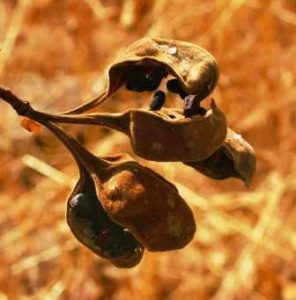
Sterculia quinqueloba . Photo: Bart Wursten. Source: Flora of Zimbabwe
Sterculia quinqueloba (large-leaved star-chestnut) is a very easy-to-recognise tree (it must be – I can recognise it!) found on the granite highlands around Harare with its cousins Sterculia africana, Sterculia rogersii and Sterculia appendiculata generally found at lower altitudes. Those who have browsed through Common Trees of the Central Watershed Woodlands of Zimbabwe (NRB) or Trees of Southern Africa (Coates Palgrave) or Common Trees of the Highveld (Drummond & Coates Palgrave) may have noticed a small note that it produces a good quality gum although not in sufficient quantities or consistently enough to be exploited commercially. Strangely there are no notes as to the traditional medical use of this gum – strange because the gum of Sterculia species in the Indian subregion and Asia is used commercially for recognised medicinal purposes.
Sterculia B.P. and Powdered Sterculia B.P. One reference states that the gum obtained from Sterculia urens and other species of Sterculia (Sterculiaceae) when prepared for pharmaceutical use (Sterculia B.P.) “consists of a complex, high molecular weight, partially acetylated polysaccharide composed of D-¬galacturonic acid (about 43%), D-galactose and L-rhamnose and containing not less than 14% of volatile acid, calculated as acetic acid”. In essence that means that the gum contains a molecule even more complex than starch. The gum often has a faint odour of acetic acid (like vinegar) and can be dried to form a powder (pharmaceutical grade would have no less than 10% acetic acid), which is how it is commonly used medically. Other names for Sterculia gum include Indian Tragacanth and Karaya gum.
Medical Uses of Sterculia B.P
Sterculia gum is only slightly soluble in water but it does absorb water to form a gelatinous mass and this is the basis for most of its applications (those of a weak stomach [excuse the pun] should skip to the final paragraph).
- Constipation – Sterculia gum is a bulk laxative useful for the management of constipation associated with haemorrhoids, anal fissure and other chronic constipation, especially in those patients who cannot tolerate bran fibre. It acts by absorbing water within the intestines, bulking up the faeces and thus inducing peristaltic movements.
- Diarrhoea – Sterculia gum is also used when the gastrointestinal system is overactive. It finds a particular use in chronic diarrhoea associated with diverticulitis and ulcerative colitis (if you don’t recognise any of these words be grateful!). Again, its absorption of excess water and bulking of the faeces is responsible for its effect.
- Due to its adhesive properties, Sterculia gum is also sometimes used in the fitting of ileostomy and colostomy bags/appliances and in dental fixative powders. In the former case, it had advantages over adhesive plasters and types of cement in that it tends to be soothing to the skin and less likely to produce soreness.
- Sterculia B.P. is also used as a suspending and thickening agent in medicated jellies, suspensions and pastes although tragacanth is more commonly used (tragacanth gum is obtained from Astragalus gummifer and other Asiatic species of Astragalus [Leguminosae], a genus which I do not believe is present in Southern Africa).
- Powdered Sterculia has occasionally been used to help heal resistant pressure (bed) sores.
Conclusion
Although Sterculia gum has these many varied uses it is not actually used all that often in medical practice. Unfortunately, it is not available in Zimbabwe for use as a laxative or anti-diarrhoeal. However, next time you encounter Sterculia sp. in the great outdoors; remember that there’s a lot more to it than meets the eye.
-Douglas Ball
ANDY MACNAUGHTAN CHAIRMAN


